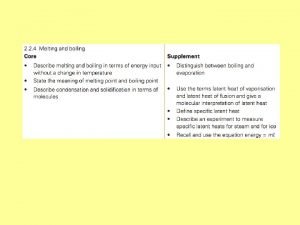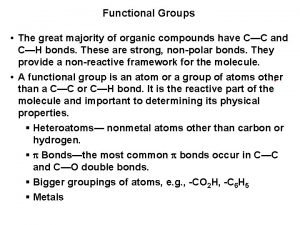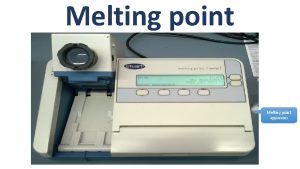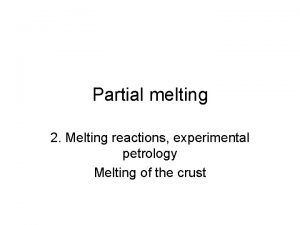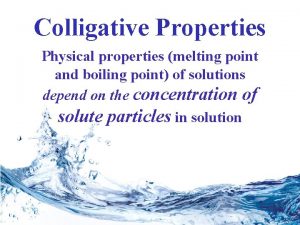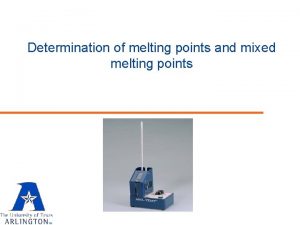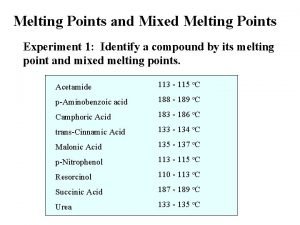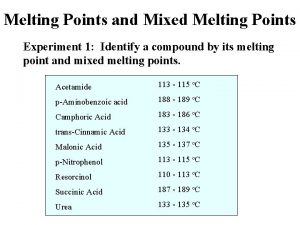EXPERIMENT 1 MELTING POINT DETERMINATION Useful physical properties









- Slides: 9

EXPERIMENT 1 MELTING POINT DETERMINATION

Useful physical properties in identifying an organic compound include color , odor , physical state , melting point(M. P. ) , boiling point (B. P. ) , density (d) , infrared (ir) spectrum , nuclear magnetic (NMR) spectrum and ultraviolet (UV) spectrum. As long as the physical constants are determined under standard conditions (temperature, pressure, etc. ) , they are invariant and therefore useful in helping to determine the identity of unknown substances.

The melting point (mp) of a substance is one of the physical properties that chemists use to identify a substance. The melting point of solid crystalline compound is the temperature at which the solid begins to change into liquid under a pressure of one atmosphere, or it is the temperature at which there is equilibrium between liquid and solid states. If the resultant liquid is cooled, solidification will occur at the same temperature, i. e. the melting point and the freezing point for a pure substance are identical. (The melting point is considered as a criterion of purity of a compound and is useful for identification of organic compounds).


-The freezing point of liquid : is the same temperature as the melting point of its solid. however freezing point are rarely measured in practice because they are more difficult to determine. -Some solid pass directly from the solid state to the gaseous state without first liquefying this phenomenon is called sublimation. -The temperature at which sublimation occurs is called the sublimation point. -Other solids decompose rather than melt the temperature at which a solid decompose is the decompose point.

A pure crystalline organic compound usually has a sharp and characteristic melting point range of 0. 5 to (1) 0 C. The “melting point range” is determined by recording the temperature at which melting first T 1 begins and the temperature at which melting is complete T 2. You may recall that impurities depress the melting (freezing) point of a substance. They also increase the range of melting. When a sample melts at a lower than expected temperature over an extended range, this is a sign that the sample was not pure. The same idea will apply for pure organic compounds if they undergo slight decomposition before reaching the melting point. The decomposition products act as impurities that decrease the melting point and increase the melting point

FACTORS INFLUENCING • 1 - Molecular Weight: Increase molecular weight Leads to increase melting point. Why? • 2 - Impurity of compound : organic impurity and inorganic leads to decrease melting point and increases meting point range. • 3 - Wetness increases melting point because H-bonds.

A technique known as a “mixed melting point” may be used as additional evidence in identifying a given compound. Suppose that you have two solid samples (A and B) with the same melting point. If you do not know whether these two samples are the same or different, you can mix them and measure the melting point for the resultant mixture. If A and B are different, one of them will act as an impurity for the other and the measured melting point will be lower than the original one with a higher melting point range. On the other hand, if the measured melting point is the same as the original one, A and B represent the same compound

Recipes Oil bath: 1. Has a high boiling point reaches 300 C. 2. Does not liberate toxic fumes. 3 - It has a higher density than the density of water, which helps to deliver heat to the material in a calm and harmonious. 4 -Has a high transparency so that vision through. 5 -Does not come apart.
 Congruent melting compound
Congruent melting compound Boiling point determination experiment
Boiling point determination experiment Chocolate experiment
Chocolate experiment The melting point of ice
The melting point of ice Ion solvent interaction
Ion solvent interaction Determination of curie temperature experiment
Determination of curie temperature experiment Chemical property of matter
Chemical property of matter Shipping point determination
Shipping point determination Shipping point determination sap
Shipping point determination sap Mothballs vaporizing chemical physical change
Mothballs vaporizing chemical physical change



